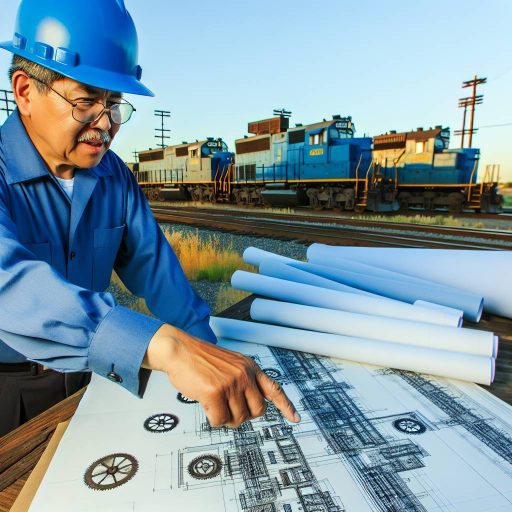Introduction
Railroad engineering involves the design, construction, and maintenance of railway systems.
It plays a crucial role in transportation infrastructure.
Railroad engineering ensures the safe and efficient movement of goods and people.
Precision in railroad engineering is paramount for various reasons.
Safety regulations and standards
One of the most critical aspects of railroad engineering is ensuring safety through precision in design and construction.
The following points highlight the significance of precision in adhering to safety regulations and standards:
Importance of precision in ensuring safety
- Precision in railroad engineering is essential for maintaining the structural integrity of tracks and infrastructure.
- Accuracy in alignment and measurements prevents derailments and accidents, safeguarding passengers and cargo.
- Adherence to specific standards for materials and construction techniques ensures durability and reliability of railroad systems.
- Regular inspections and maintenance routines rely on precise engineering to identify potential hazards and prevent accidents.
- Strict compliance with safety regulations minimizes the risk of incidents and enhances overall operational efficiency.
Examples of past accidents due to lack of precision in engineering
- The Montparnasse derailment in Paris, 1895, resulted from a train overshooting the platform due to faulty brakes and alignment.
- The Eschede train disaster in Germany, 1998, was caused by a wheel detachment due to inadequate maintenance and inspections.
- The Big Bayou Canot train wreck in Alabama, 1993, occurred due to a misaligned bridge causing a freight train to derail.
- The Amagasaki rail crash in Japan, 2005, resulted from speeding and a poorly designed curve on the track.
- The Santiago de Compostela derailment in Spain, 2013, occurred due to excessive speed and human error in signaling.
These tragic events serve as stark reminders of the consequences of overlooking precision in railroad engineering.
The role of precision in ensuring safety cannot be overstated, as even the slightest miscalculation or oversight can lead to catastrophic accidents.
Engineering practices must prioritize accuracy and attention to detail to protect lives and property.
Efficient operations and maintenance in the railroad industry are crucial for ensuring the smooth running of trains and tracks.
How precision in design and construction leads to smoother operations
- Precision in design ensures that tracks are laid out accurately, reducing the risk of derailments and accidents.
- Well-constructed bridges and tunnels help trains move smoothly without any disruptions, improving overall efficiency.
- Accurate signaling systems allow for better coordination between trains, enhancing safety and efficiency.
- Precise alignment of tracks reduces wear and tear on trains, leading to longer lifespan and lower maintenance costs.
- Regular inspections and maintenance of infrastructure ensure that any issues are addressed promptly, minimizing delays.
Cost-saving benefits of precision in maintenance
- By identifying potential issues early on, precision in maintenance helps avoid major breakdowns that can be costly to repair.
- Efficient maintenance schedules based on accurate data reduce downtime for trains, maximizing revenue generation.
- Properly maintained tracks and equipment lead to fewer accidents, saving money on insurance premiums and legal fees.
- Investing in precision tools and technology for maintenance can result in long-term cost savings by extending the lifespan of assets.
- Well-maintained infrastructure attracts more passengers and businesses to use rail services, boosting revenue for the industry.
Precision in railroad engineering is essential for ensuring efficient operations and cost-effective maintenance.
By focusing on accuracy and attention to detail, the industry can improve safety, reliability, and profitability in the long run.
Gain More Insights: Career Opportunities in Transportation Urban Planning
Environmental impact
Precision in railroad engineering is not only crucial for safety and efficiency but also has a significant impact on the environment.
By ensuring precise measurements and calculations, engineers can minimize the environmental footprint of railroad projects.
One of the key ways in which precision in engineering contributes to reducing environmental impact is through efficient use of resources.
When railroads are designed with accuracy and attention to detail, there is less wastage of materials, energy, and resources.
Additionally, precise engineering helps optimize the use of land and space, reducing the need for extensive land clearing and disruption of natural habitats.
This is especially important in environmentally sensitive areas where preserving the ecosystem is a priority.
Furthermore, precision in railroad engineering plays a vital role in minimizing pollution and emissions.
Transform Your Career Today
Unlock a personalized career strategy that drives real results. Get tailored advice and a roadmap designed just for you.
Start NowBy designing railroads with precision, engineers can create infrastructure that allows for smooth operations, reducing the carbon footprint associated with transportation.
Sustainable practices in railroad engineering are essential to safeguarding the environment for future generations.
By prioritizing precision in design and construction, engineers can ensure that railroads are built in a way that minimizes negative impacts on the environment.
Implementing sustainable practices in railroad engineering involves considering the long-term consequences of design choices and construction methods.
This includes using environmentally friendly materials, optimizing energy efficiency, and minimizing waste generation throughout the project lifecycle.
Moreover, sustainable railroad engineering practices go hand in hand with precision in design and construction.
By incorporating environmental considerations into every aspect of the project, engineers can create infrastructure that is both efficient and environmentally responsible.
Precision in railroad engineering is essential for reducing the environmental impact of transportation infrastructure.
By embracing sustainable practices and prioritizing accuracy in design and construction, engineers can build railroads that not only meet the needs of today but also protect the planet for future generations.
See Related Content: Logistics Technician vs. Supply Chain Manager
Impact on Infrastructure Development
Precision in railroad engineering affects overall infrastructure planning.
Accuracy ensures efficient use of resources and budget allocation.
Proper planning reduces risks of delays and unexpected costs.
How Precision Contributes to Economic Growth and Development
High precision in railroad engineering leads to better operational efficiency.
Efficient transportation systems enable smoother movement of goods and people.
Improved connectivity boosts trade and commerce in surrounding areas.
Reliable infrastructure attracts investments and stimulates economic growth.
Precision in railroad engineering plays a vital role in the development of infrastructure and the economy.
By ensuring accuracy in design and construction, engineers can create efficient transportation networks that benefit society as a whole.
Delve into the Subject: Key Challenges Faced by Packaging Engineers
Transform Your Career Today
Unlock a personalized career strategy that drives real results. Get tailored advice and a roadmap designed just for you.
Start Now
Importance of Precision in Railroad Engineering
When it comes to railroad engineering, precision plays a crucial role in ensuring the safety and efficiency of railway systems.
The accuracy and exactness in planning, designing, constructing, and maintaining railroad infrastructure are vital for smooth operations.
This section will explore the importance of precision in railroad engineering and how technology and innovation are driving advancements in this field.
Technology and Innovation
Technology has revolutionized the way railroad engineering is carried out.
It offers new tools and techniques that significantly enhance precision in various aspects of the industry.
From planning and design to construction and maintenance, technology plays a pivotal role in improving accuracy and efficiency.
Role of Technology in Enhancing Precision in Railroad Engineering
- Surveying and mapping technologies: Advanced surveying tools such as LiDAR, GPS, and drones enable precise mapping of terrain and track alignment, ensuring accurate design and construction.
- Simulation and modeling software: Virtual simulations and modeling software allow engineers to visualize the behavior of trains, tracks, and infrastructure before actual implementation, leading to better decision-making and precision.
- Machine learning and artificial intelligence: AI algorithms can analyze vast amounts of data to optimize scheduling, maintenance, and infrastructure design, resulting in improved accuracy and efficiency.
- IoT and sensor technology: Internet of Things (IoT) devices and sensors monitor track conditions, train performance, and equipment health in real time, enabling proactive maintenance and ensuring operational precision.
Advancements in Tools and Techniques Improving Precision
- 3D printing: Additive manufacturing technology allows for the production of complex rail components with high precision, reducing lead times and costs while improving reliability.
- Laser scanning: High-precision laser scanning technology helps detect track imperfections, gauge defects, and alignment issues, facilitating preventive maintenance and enhancing safety.
- Augmented reality: AR applications can assist maintenance technicians by overlaying digital information onto physical railway assets, guiding them with precision during inspections and repairs.
- Automated track inspection systems: Sensors mounted on trains or tracks collect data on track geometry, defects, and wear, enabling predictive maintenance and ensuring precise track conditions.
Technology and innovation are driving significant advancements in railroad engineering.
These advancements enhance precision, safety, and efficiency across the industry.
By leveraging cutting-edge tools and techniques, engineers can achieve higher levels of accuracy and reliability in all aspects of railway operations.
This ultimately leads to better service for passengers and freight alike.
Delve into the Subject: Warehouse Supervisor: Problem-Solving Techniques
Training and education
Railroad engineering is a specialized field that requires a high level of precision in order to ensure the safety and efficiency of train operations.
One of the key factors that contribute to precision in railroad engineering is the training and education of engineers and workers involved in the industry.
Proper Training for Engineers and Workers
Proper training is essential for engineers and workers in the railroad industry to effectively perform their roles and responsibilities.
This training provides them with the necessary skills and knowledge to execute their tasks with precision.
Engineers need to be trained in various aspects of railroad engineering, including track design, maintenance, and safety regulations.
They must also understand how to use specialized equipment and technology to ensure the smooth operation of trains.
Workers, such as maintenance crews and signal technicians, also require specialized training to carry out their duties effectively.
Without proper training, these workers may make mistakes that could lead to derailments, accidents, or other safety hazards.
By investing in training programs for engineers and workers, railroad companies can ensure that their employees are well-equipped to handle the challenges of the industry with precision and accuracy.
Transform Your Career Today
Unlock a personalized career strategy that drives real results. Get tailored advice and a roadmap designed just for you.
Start NowRole of Education in Promoting Precision in Railroad Engineering
Education plays a crucial role in promoting precision in railroad engineering by providing a strong foundation of theoretical knowledge and practical skills to professionals in the field.
Engineers who have received a formal education in railroad engineering are better equipped to understand the complexities of the industry and apply their knowledge to solve problems and make informed decisions.
Education also fosters a culture of continuous learning and improvement within the industry.
Engineers and workers who value education are more likely to seek out new knowledge and skills to stay updated on the latest advancements in railroad engineering.
Furthermore, education helps to standardize practices and procedures within the industry.
This ensures that all professionals adhere to the same high standards of precision and quality in their work.
Importance of Precision in Railroad Engineering
Precision in railroad engineering is crucial for ensuring safety, efficiency, and reliability of railway systems.
Every detail matters when it comes to designing, constructing, and maintaining railway infrastructure.
Industry professionals must prioritize precision in their work to prevent accidents, minimize operational costs, and enhance the overall performance of the railway network.
By paying attention to the smallest details, engineers can ensure that trains run smoothly and passengers arrive safely at their destinations.
It is essential for railroad engineers to constantly strive for accuracy and perfection in their projects.
The margin for error in this field is minimal, and any mistake can have serious consequences.
A commitment to precision is vital for the success and sustainability of the railway industry.
As we move forward in the development of railway transportation, let us remember the importance of precision in every aspect of railroad engineering.
By adhering to strict standards and maintaining a focus on accuracy, we can build a safer, more efficient, and more reliable railway system for the future.
Let us all work together to uphold the highest level of precision in railroad engineering.
This dedication is for the sake of both the industry and the passengers who rely on this mode of transportation.
Our collective commitment to precision will ensure the continued growth and success of the railway sector.
Additional Resources
Transportation Statistics Annual Report 2023
The Best Railroad Resources – UP
Transform Your Career Today
Unlock a personalized career strategy that drives real results. Get tailored advice and a roadmap designed just for you.
Start Now



